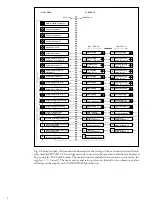
7
Control signals
between the
modules
The figure below schematically illustrates how
the starting, tripping, control and blocking sig-
nals can be programmed to obtain the required
function of the protection relay.
IL1
IL2
IL3
SGR1 / 3
SGR2 / 5
I>, Is
I>>
t>>
t>, ts
to>, ko
Io>
Io
BS
SGB / 1
SGB / 2
SGB / 4
SGB / 5
SGB / 6
EXTERNAL TRIP
RELAY RESET
1
SGB / 7
RESET+
PROGRAM
1
SGB / 8
RESET+
PROGRAM
1
SS1
SS2
SPCJ 4D34
TS1
TS2
SS3
RESET
TRIP
A
B
C
D
F
IRF
E
RESTART
ENABLE
START /
PRIOR ALARM
PRIOR ALARM /
SIGNAL 2
SIGNAL1
TRIP
IRF
(AR2)
(AR1)
(AR3)
SPTU ___R2
INTERNAL SIGNAL DIAGRAM
I ,t
Θ
START
i
a
t
Θ
∆
I
t
∆
I<
t<
RESTART INH.
∑
ts
SGR2 / 1
SGR1 / 1
SGR2 / 4
SGR1 / 2
SGR1 / 4
SGR1 / 5
SGR2 / 6
SGR1 / 7
SGR2 / 8
SGR1 / 6
SGR2 / 7
SGR1 / 8
SGR2 / 3
STALL
RESTART
INH.
SGB / 3
SGR2 / 2
1
Θ>Θ
Θ>Θ
Θ>Θ
SG4 / 3
SG4 / 2
6x
Fig. 4. Control signals between the modules of the motor protection relay SPAM 150 C.
the measuring relay module. The functions of
the different switches are explained in the user´s
manual of the measuring module SPCJ 4D34.
The functions of the blocking and starting sig-
nals are selected with the switches of switchgroups
SGF, SGB and SGR. The checksums of the
switchgroups are found in the setting menu of
Abbreviations of
signal names
I
L1
, I
L2
, I
L3
Phase currents
I
0
Neutral current
BS
Blocking or control Signal
SS1
Start Signal 1
SS2
Start Signal 2
SS3
Start Signal 3
TS1
Trip Signal 1
TS2
Trip Signal 2
AR1...3
Auto-Reclose start signals (not in use in SPAM 150 C)
IRF
Internal Relay Fault signal
SGF
Switch Group for Functions
SGB
Switch Group for Blockings
SGR1...2
Switch Groups for Relay configuration






































